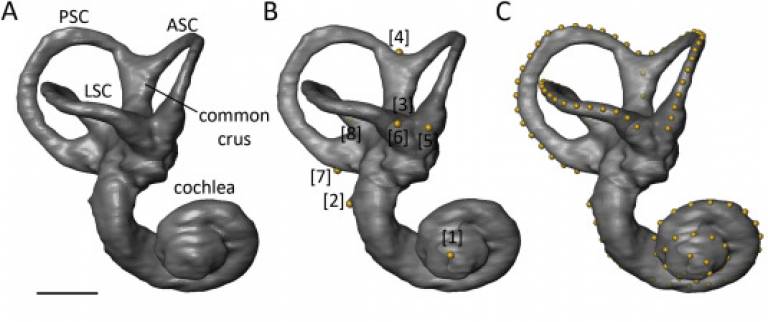The bony labyrinth of StW 573 representing Australopithecus prometheus shares similarities with StW 578
6 January 2019
Because of its exceptional degree of preservation and its geological age of ∼3.
 67 Ma, StW 573 makes an invaluable contribution to our understanding of early hominin evolution and paleobiology. The morphology of the bony labyrinth has the potential to provide information about extinct primate taxonomic diversity, phylogenetic relationships and locomotor behaviour. In this context, we virtually reconstruct and comparatively assess the bony labyrinth morphology in StW 573. As comparative material, we investigate 17 southern African hominin specimens from Sterkfontein, Swartkrans and Makapansgat (plus published data from two specimens from Kromdraai B), attributed to Australopithecus, early Homo or Paranthropus, as well as 10 extant human and 10 extant chimpanzee specimens. We apply a landmark-based geometric morphometric method for quantitatively assessing labyrinthine morphology. Morphology of the inner ear in StW 573 most closely resembles that of another Australopithecus individual from Sterkfontein, StW 578, recovered from the Jacovec Cavern. Within the limits of our sample, we observe a certain degree of morphological variation in the Australopithecus assemblage of Sterkfontein Member 4. Cochlear morphology in StW 573 is similar to that of other Australopithecus as well as to Paranthropus specimens included in this study, but it is substantially different from early Homo. Interestingly, the configuration of semicircular canals in Paranthropus specimens from Swartkrans differs from other fossil hominins, including StW 573. Given the role of the cochlea in the sensory-driven interactions with the surrounding environment, our results offer new perspectives for interpreting early hominin behaviour and ecology. Finally, our study provides additional evidence for discussing the phylogenetic polarity of labyrinthine traits in southern African hominins.
67 Ma, StW 573 makes an invaluable contribution to our understanding of early hominin evolution and paleobiology. The morphology of the bony labyrinth has the potential to provide information about extinct primate taxonomic diversity, phylogenetic relationships and locomotor behaviour. In this context, we virtually reconstruct and comparatively assess the bony labyrinth morphology in StW 573. As comparative material, we investigate 17 southern African hominin specimens from Sterkfontein, Swartkrans and Makapansgat (plus published data from two specimens from Kromdraai B), attributed to Australopithecus, early Homo or Paranthropus, as well as 10 extant human and 10 extant chimpanzee specimens. We apply a landmark-based geometric morphometric method for quantitatively assessing labyrinthine morphology. Morphology of the inner ear in StW 573 most closely resembles that of another Australopithecus individual from Sterkfontein, StW 578, recovered from the Jacovec Cavern. Within the limits of our sample, we observe a certain degree of morphological variation in the Australopithecus assemblage of Sterkfontein Member 4. Cochlear morphology in StW 573 is similar to that of other Australopithecus as well as to Paranthropus specimens included in this study, but it is substantially different from early Homo. Interestingly, the configuration of semicircular canals in Paranthropus specimens from Swartkrans differs from other fossil hominins, including StW 573. Given the role of the cochlea in the sensory-driven interactions with the surrounding environment, our results offer new perspectives for interpreting early hominin behaviour and ecology. Finally, our study provides additional evidence for discussing the phylogenetic polarity of labyrinthine traits in southern African hominins.
The bony labyrinth of StW 573 ("Little Foot"): Implications for early hominin evolution and paleobiology
Amélie Beaudet, Ronald J. Clarke, Laurent Bruxelles, Kristian J. Carlson, Robin Crompton, Frikkie de Beer, Jelle Dhaene, Jason L. Heaton, Kudakwashe Jakata, Tea Jashashvili, Kathleen Kuman, Juliet McClymont, Travis R. Pickering, Dominic Stratford
DOI: 10.1016/j.jhevol.2018.12.002
 Close
Close

